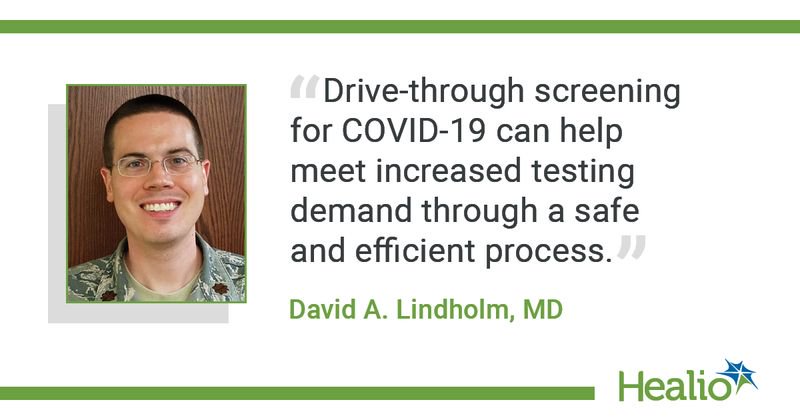Drive-through COVID-19 testing offers ‘safe and efficient’ screening
Drive-through COVID-19 screening is an efficient way to safely screen large numbers of people — including health care workers — and can reduce health care exposures and save personal protective equipment, according to a study.
The analysis, which was published in Open Forum Infectious Diseases, included 979 patients who were screened at Brooke Army Medical Center in San Antonio, Texas.

“Drive-through screening for COVID-19 can help meet increased testing demand through a safe and efficient process,” Maj. David A. Lindholm, MD, assistant professor of medicine at the Uniformed Services University, told Healio. “Optimal drive-through screening involves rapid turnaround of test results and linkage to follow-up care.”
Lindholm and colleagues collected demographic information, military duty and beneficiary status, information on recent travel and contact with confirmed COVID-19 cases and symptoms via a questionnaire through an open window in a lot across from the hospital. They tested patients for SARS-CoV-2 if a symptomatic beneficiary or epidemiologic link to COVID-19 was found on the participants’ questionnaires.
Of the participants, 1.5% presented multiple times and 75% were tested. Tests were performed in-house for 35.1% of patients and outsourced for 64.9% of participants, with median turnaround times of 25 hours and 221 hours, respectively. A higher percentage of health care workers and active-duty members were tested compared with the general population. The median patient age was 36 years.
Test results were positive in 6.3% of patients and were more common in women than men (8.2% vs. 4.5%; P = .04). None of health care workers tasked with screening or collecting samples from patients were diagnosed with COVID-19. Only 1.2% of total patients were hospitalized.
“We were pleased to see the relatively low rate of patients requiring immediate disposition to the emergency department or ultimate hospitalization,” Lindholm said. “However, the median time from screening to admission (1 day) — and admission typically for a non-COVID-19-related diagnosis — suggests that some patients requiring additional medical evaluation may have reported to our drive through. This comes back to one of our take-home messages: optimal drive-through screening should include linkage to follow-up care, especially for those whose presentation is more medically complex or concerning.”
Lindholm noted that the study’s limitations included the exclusion of admission outside of facilities and the inability to capture time to notification for patients’ test results.
“Our analysis was also focused on a time period early in the epidemic, soon after recognition of local transmission,” he said. “With changes in local epidemiology, increased cases and hospitalizations in San Antonio over the past 1 to 2 months and differences in testing capacity, it would be interesting to repeat and expand our analysis to get a better sense of how our ongoing drive-through screening has adapted to better serve our patient population safely and efficiently during the recent surge. This would allow us to further optimize our processes.”

